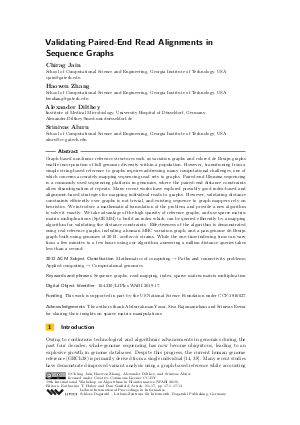@InProceedings{jain_et_al:LIPIcs.WABI.2019.17,
author = {Jain, Chirag and Zhang, Haowen and Dilthey, Alexander and Aluru, Srinivas},
title = {{Validating Paired-End Read Alignments in Sequence Graphs}},
booktitle = {19th International Workshop on Algorithms in Bioinformatics (WABI 2019)},
pages = {17:1--17:13},
series = {Leibniz International Proceedings in Informatics (LIPIcs)},
ISBN = {978-3-95977-123-8},
ISSN = {1868-8969},
year = {2019},
volume = {143},
editor = {Huber, Katharina T. and Gusfield, Dan},
publisher = {Schloss Dagstuhl -- Leibniz-Zentrum f{\"u}r Informatik},
address = {Dagstuhl, Germany},
URL = {https://drops.dagstuhl.de/entities/document/10.4230/LIPIcs.WABI.2019.17},
URN = {urn:nbn:de:0030-drops-110470},
doi = {10.4230/LIPIcs.WABI.2019.17},
annote = {Keywords: Sequence graphs, read mapping, index, sparse matrix-matrix multiplication}
}

 Creative Commons Attribution 3.0 Unported license
Creative Commons Attribution 3.0 Unported license






































